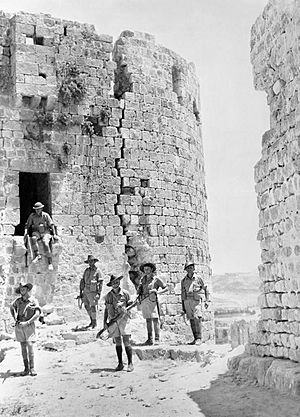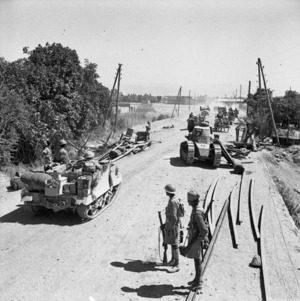Syria–Lebanon campaign facts for kids
Quick facts for kids Syria–Lebanon campaign |
|||||||||
|---|---|---|---|---|---|---|---|---|---|
| Part of the Mediterranean and Middle East theatre of the Second World War | |||||||||
 Australian troops among the ruins of the Sidon Sea Castle, Lebanon, July 1941 |
|||||||||
|
|||||||||
| Belligerents | |||||||||
|
|
|
||||||||
| Commanders and leaders | |||||||||
| Strength | |||||||||
|
~34,000 troops
1 landing ship< 5 cruisers 8 destroyers |
Vichy France: ~35,000 troops
289 aircraft 2 destroyers 3 submarines German Luftwaffe: At least 10 bomber aircraft |
||||||||
| Casualties and losses | |||||||||
| c. 4,652 Australian: 1,552 Free French: c. 1,300 British and Indian: 1,800, 1,200 POW, 3,150 sick 41 aircraft |
Vichy France: 6,352 (Vichy figures) 8,912 (British figures) 179 aircraft 1 submarine sunk 5,668 defectors Germany: 4 aircraft |
||||||||
The Syria–Lebanon campaign, also called Operation Exporter, was a military invasion during World War II. It took place in June and July 1941. Forces from the British Empire and Free France invaded Syria and Lebanon. At that time, these areas were controlled by Vichy France, which was allied with Nazi Germany.
The goal of the invasion was to stop the Axis powers (Germany and Italy) from using Syria and Lebanon as bases. These bases could have been used to attack Egypt, where British forces were fighting. The campaign lasted for about five weeks. It ended with a victory for the British and Free French forces. Syria and Lebanon then came under the control of Free France.
Contents
Why the Campaign Happened
In 1941, there was a coup in Iraq. This country was next to Syria. Iraqi nationalists took control and asked for help from Germany and Italy. During the Anglo-Iraqi War that followed, German planes used airfields in Syria to attack British forces in Iraq.
Admiral François Darlan, a leader in Vichy France, allowed this. He was not friendly towards the British. The British were worried that Germany might use Syria and Lebanon as a threat to Egypt. They also feared Germany might connect with Vichy forces if they defeated the Soviet Union.
Getting Ready for Battle
Vichy French Forces
General Henri Dentz led the Vichy French forces in Syria and Lebanon. His army had about 35,000 soldiers. This included 8,000 French troops and 25,000 Syrian and Lebanese soldiers. They also had 90 tanks and 289 aircraft. The French Navy had two destroyers and three submarines.
German aircraft were seen using Syrian airfields in May 1941. The British Royal Air Force (RAF) started attacking these airfields. Vichy French planes also shot down some British aircraft. Even though Germany's interest in Syria was small, Adolf Hitler allowed more French planes to fly to Syria. This showed support for Vichy France.
British and Allied Forces
The British-led invasion aimed to stop Germany from using Syria and Lebanon. British forces in Mandatory Palestine were led by General Sir Henry Maitland Wilson. His troops included the Australian 7th Division, two Free French brigades, and the 5th Indian Infantry Brigade.
Other forces came from Iraq. These included the 10th Indian Infantry Division and a group called Habforce. Special commando units also helped. The RAF and Royal Australian Air Force (RAAF) provided air support. The Royal Navy and Royal Australian Navy ships helped by firing on coastal targets.
At the start, the British and Commonwealth forces had about 34,000 men. This included 18,000 Australians, 9,000 British, 2,000 Indian, and 5,000 Free French troops. They had about 50 aircraft and several navy ships.
The Invasion Plan
General Wilson's plan involved four main attack routes.
- One force would advance from Palestine towards Damascus and Beirut.
- Another would move from Iraq into northern and central Syria, aiming for Palmyra and Tripoli.
The Australian 7th Division would advance along the coast towards Beirut. The 21st Australian Brigade would take Beirut. The 25th Australian Brigade would attack the large Vichy French airbase at Rayak. Commandos would also land from Cyprus.
A force from Iraq would advance along the Euphrates River towards Aleppo. This was meant to cut off Vichy supply lines. Another group would capture territory in north-eastern Syria. Habforce would advance to take Palmyra and secure the oil pipeline.
The Campaign in Action
Hostilities began on June 8, 1941. The campaign involved battles on land, in the air, and at sea.
Battles on Land
- Battle of the Litani River (June 9): Part of the advance on Beirut.
- Battle of Jezzine (June 13): Another part of the advance on Beirut.
- Battle of Sidon (June 13–15): Key battle in the advance on Beirut.
- Battle of Kissoué (June 15–17): Part of the advance on Damascus.
- Battle of Damascus (June 18–21): Capture of the capital.
- Battle of Merdjayoun (June 19–24): Important battle for both Beirut and Damascus.
- Battle of Palmyra (July 1): Part of the advance from Iraq.
- Battle of Deir ez-Zor (July 3): Part of the advance in central Syria.
- Battle of Damour (July 5–9): Final push towards Beirut.
- Battle of Beirut (July 12): The city was about to fall.
War in the Air
The Vichy French Air Force initially had an advantage. However, they soon lost many aircraft. Most were destroyed on the ground. The flat land and lack of anti-aircraft defenses made them easy targets.
On June 26, Australian planes destroyed five French fighter planes at Homs airfield. On July 10, French planes attacked British bombers. The French lost at least four planes. By the end of the campaign, Vichy forces had lost 179 aircraft. Many of their remaining planes flew to Rhodes.
War at Sea
Naval battles were not a major part of the campaign. However, some important actions took place. On June 9, French destroyers fired on Australian troops at the Litani River. British destroyers and a New Zealand cruiser drove them away.
On June 16, British torpedo planes sank the French destroyer Chevalier Paul. This ship was carrying ammunition. The next day, British bombers attacked another French destroyer in Beirut. On June 25, a British submarine sank the French submarine Souffleur.
The End of the Campaign
On July 10, the Australian 21st Brigade was close to entering Beirut. General Dentz asked for a ceasefire. The fighting stopped at one minute past midnight on July 12.
The official agreement, called the Armistice of Saint Jean d'Acre, was signed on July 14. It took place at the Sidney Smith Barracks near the city of Acre.
What Happened Next
Casualties and Losses
Vichy French forces reported about 6,352 casualties. This included 521 killed, 1,790 wounded, and 3,004 taken prisoner. They also lost 179 aircraft and one submarine. About 5,668 Vichy soldiers joined the Free French side.
British and Commonwealth forces had about 4,652 casualties. Australians suffered 1,552 casualties (416 killed, 1,136 wounded). The Free French had about 1,300 losses. British and Indian forces had 1,800 wounded and 1,200 captured. The RAF and RAAF lost 27 aircraft.
After the armistice, 37,563 Vichy military and civilian personnel were sent back to France. British prisoners of war were returned.
Changes in Leadership
The British leader, General Archibald Wavell, was replaced on July 5. This was partly because he was slow to send troops to Iraq.
In late July 1941, Free French General Charles de Gaulle visited to celebrate the victory. General Georges Catroux was put in charge of Syria and Lebanon. On November 26, Catroux declared Syria and Lebanon independent in the name of the Free French movement.
Lebanon became fully independent on November 22, 1943. Syria and Lebanon later declared war on Germany and Japan in 1945.
Later Events
After World War II, France still had a presence in Syria and Lebanon. This led to protests by nationalists. In 1945, there were heavy casualties in Damascus. Winston Churchill opposed France's actions. He ordered British forces to intervene and stop the French.
This event was known as the Levant Crisis. British troops reached Damascus and confined the French to their barracks. Under political pressure, De Gaulle ordered a ceasefire. France withdrew from Syria the following year.
Images for kids
-
Allied leaders meet in Syria. Left to right: Air Chief Marshal Longmore, General Wavell, General de Gaulle, General Catroux
See also
- Syria-Lebanon Campaign order of battle
- Asmahan
- Attack on Mers-el-Kébir
- 1936–1939 Arab revolt in Palestine
- Franco-Syrian Treaty of Independence (1936)
- Italian bombings on Palestine in World War II
- French Colonial Empire
- List of French possessions and colonies
- Moshe Dayan#Eye patch







